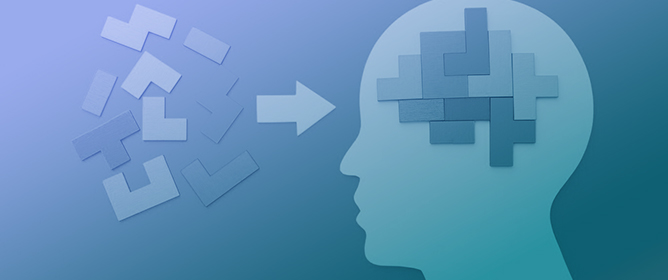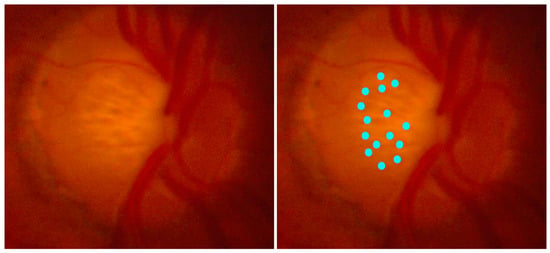Journal Description
Vision
Vision
is an international, peer-reviewed, open access journal on vision published quarterly online by MDPI.
- Open Access— free for readers, with article processing charges (APC) paid by authors or their institutions.
- High Visibility: indexed within Scopus, PubMed, PMC, and other databases.
- Journal Rank: CiteScore - Q2 (Ophthalmology)
- Rapid Publication: manuscripts are peer-reviewed and a first decision is provided to authors approximately 27.8 days after submission; acceptance to publication is undertaken in 3.8 days (median values for papers published in this journal in the second half of 2023).
- Recognition of Reviewers: reviewers who provide timely, thorough peer-review reports receive vouchers entitling them to a discount on the APC of their next publication in any MDPI journal, in appreciation of the work done.
Latest Articles
Features Associated with Visible Lamina Cribrosa Pores in Individuals of African Ancestry with Glaucoma: Primary Open-Angle African Ancestry Glaucoma Genetics (POAAGG) Study
Vision 2024, 8(2), 24; https://doi.org/10.3390/vision8020024 - 18 Apr 2024
Abstract
►
Show Figures
There are scarce data regarding the rate of the occurrence of primary open-angle glaucoma (POAG) and visible lamina cribrosa pores (LCPs) in the eyes of individuals with African ancestry; the potential impact of these features on disease burden remains unknown. We recruited subjects
[...] Read more.
There are scarce data regarding the rate of the occurrence of primary open-angle glaucoma (POAG) and visible lamina cribrosa pores (LCPs) in the eyes of individuals with African ancestry; the potential impact of these features on disease burden remains unknown. We recruited subjects with POAG to the Primary Open-Angle African American Glaucoma Genetics (POAAGG) study. Through regression models, we evaluated the association between the presence of LCPs and various phenotypic features. In a multivariable analysis of 1187 glaucomatous eyes, LCPs were found to be more likely to be present in eyes with cup-to-disc ratios (CDR) of ≥0.9 (adjusted risk ratio (aRR) 1.11, 95%CI: 1.04–1.19, p = 0.005), eyes with cylindrical-shaped (aRR 1.22, 95%CI: 1.11–1.33) and bean pot (aRR 1.24, 95%CI: 1.13–1.36) cups versus conical cups (p < 0.0001), moderate cup depth (aRR 1.24, 95%CI: 1.06–1.46) and deep cups (aRR 1.27, 95%CI: 1.07–1.50) compared to shallow cups (p = 0.01), and the nasalization of central retinal vessels (aRR 1.33, 95%CI: 1.23–1.44), p < 0.0001). Eyes with LCPs were more likely to have a higher degree of African ancestry (q0), determined by means of SNP analysis (aRR 0.96, 95%CI: 0.93–0.99, p = 0.005 for per 0.1 increase in q0). Our large cohort of POAG cases of people with African ancestry showed that LCPs may be an important risk factor in identifying severe disease, potentially warranting closer monitoring by physicians.
Full article
Open AccessArticle
The Influence of Competing Social and Symbolic Cues on Observers’ Gaze Behaviour
by
Flora Ioannidou and Frouke Hermens
Vision 2024, 8(2), 23; https://doi.org/10.3390/vision8020023 - 16 Apr 2024
Abstract
►▼
Show Figures
The effects of social (eye gaze, pointing gestures) and symbolic (arrows) cues on observers’ attention are often studied by presenting such cues in isolation and at fixation. Here, we extend this work by embedding cues in natural scenes. Participants were presented with a
[...] Read more.
The effects of social (eye gaze, pointing gestures) and symbolic (arrows) cues on observers’ attention are often studied by presenting such cues in isolation and at fixation. Here, we extend this work by embedding cues in natural scenes. Participants were presented with a single cue (Experiment 1) or a combination of cues (Experiment 2) embedded in natural scenes and were asked to ‘simply look at the images’ while their eye movements were recorded to assess the effects of the cues on (overt) attention. Single-gaze and pointing cues were fixated for longer than arrows but at the cost of shorter dwell times on the cued object. When presented together, gaze and pointing cues were fixated faster and for longer than simultaneously presented arrows. Attention to the cued object depended on the combination of cues and whether both cues were directed towards or away from the target object. Together, the findings confirm earlier observations that people attract attention more strongly than arrows but that arrows more strongly direct attention.
Full article
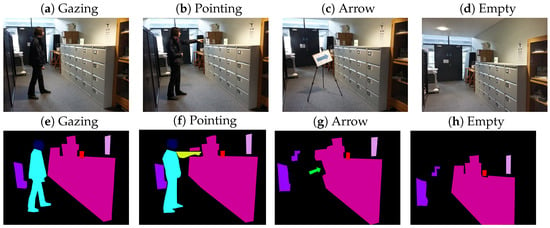
Figure 1
Open AccessArticle
An Insight into Knowledge, Perspective, and Practices of Indian Optometrists towards Childhood Myopia
by
Archana Naik, Siddharth K. Karthikeyan, Jivitha Jyothi Ramesh, Shwetha Bhaskar, Chinnappa A. Ganapathi and Sayantan Biswas
Vision 2024, 8(2), 22; https://doi.org/10.3390/vision8020022 - 16 Apr 2024
Abstract
The current understanding of clinical approaches and barriers in managing childhood myopia among Indian optometrists is limited. This research underscores the necessity and relevance of evidence-based practice guidelines by exploring their knowledge, attitude, and practice towards childhood myopia. A self-administered internet-based 26-item survey
[...] Read more.
The current understanding of clinical approaches and barriers in managing childhood myopia among Indian optometrists is limited. This research underscores the necessity and relevance of evidence-based practice guidelines by exploring their knowledge, attitude, and practice towards childhood myopia. A self-administered internet-based 26-item survey was circulated online among practicing optometrists in India. The questions assessed the demographics, knowledge, self-reported clinical practice behavior, barriers, source of information guiding their management, and extent of adult caregiver engagement for childhood myopia. Of 393 responses, a significant proportion of respondents (32.6–92.4%) were unaware of the ocular complications associated with high myopia, with less than half (46.5%) routinely performing ocular biometry in clinical practice. Despite the growing awareness of emerging myopia management options, the uptake remains generally poor, with single-vision distance full-correction spectacles (70.3%) being the most common mode of vision correction. Barriers to adopting optimal myopia care are medicolegal concerns, absence of clinical practice guidelines, and inadequate consultation time. Own clinical experience and original research articles were the primary sources of information supporting clinical practice. Most (>70%) respondents considered involving the adult caregiver in their child’s clinical decision-making process. While practitioners’ awareness and activity of newer myopia management strategies are improving, there is plenty of scope for its enhancement. The importance of evidence-based practice guidelines and continuing education on myopia control might help practitioners enhance their clinical decision-making skills.
Full article
(This article belongs to the Special Issue New Horizons in Myopia Management: Bridging Epidemiology and Clinical Innovation)
►▼
Show Figures
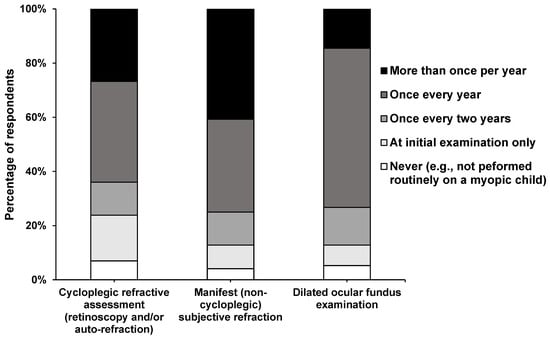
Figure 1
Open AccessArticle
Short-Term Morpho-Functional Changes before and after Strabismus Surgery in Children Using Structural Optical Coherence Tomography: A Pilot Study
by
Pasquale Viggiano, Marida Gaudiomonte, Ugo Procoli, Luisa Micelli Ferrari, Enrico Borrelli, Giacomo Boscia, Andrea Ferrara, Fabio De Vitis, Gemma Scalise, Valeria Albano, Giovanni Alessio and Francesco Boscia
Vision 2024, 8(2), 21; https://doi.org/10.3390/vision8020021 - 16 Apr 2024
Abstract
Purpose: To evaluate the immediate alterations in the thickness of the macular ganglion cell–inner plexiform layer (mGCIPL), peripapillary retinal nerve fiber layer (RNFL), inner retinal layer (IRL), and outer retinal layer (ORL) using spectral domain optical coherence tomography (SD-OCT) subsequent to strabismus surgery
[...] Read more.
Purpose: To evaluate the immediate alterations in the thickness of the macular ganglion cell–inner plexiform layer (mGCIPL), peripapillary retinal nerve fiber layer (RNFL), inner retinal layer (IRL), and outer retinal layer (ORL) using spectral domain optical coherence tomography (SD-OCT) subsequent to strabismus surgery in pediatric patients diagnosed with horizontal esotropia. Methods: Twenty-eight eyes from twenty-one child patients who had undergone uncomplicated horizontal rectus muscle surgery due to strabismus were included. Measurements of RNFL, mGCL-IPL, IRL, and ORL using structural OCT were conducted both before the surgery and one month after the surgical procedure. Importantly, a control group comprising 14 healthy eyes, matched for age and significant refractive error (<3.00 diopters), was included in the current analysis. Results: Our analysis indicated no significant disparity before and after surgery in terms of best-corrected visual acuity (BCVA), RNFL, IRL, and ORL. Conversely, concerning the macular ganglion cell layer–inner plexiform layer analysis, a substantial increase in mGCL-IPL was observed following the surgical intervention. The mean mGCL-IPL measured 60.8 ± 9.2 μm at baseline and 66.1 ± 13.2 μm one month after the surgery (p = 0.026). Notably, comparison between the strabismus group at baseline and the healthy group revealed a significant reduction in mGCL-IPL in the strabismus group (60.8 ± 9.2) compared to the healthy control group (68.3 ± 7.2; p = 0.014). Conclusions: Following strabismus surgery, our observations pointed towards a thickening of the mGCL-IPL layer, which is likely attributable to transient local inflammation. Additionally, we identified a significant differentiation in the mGCL-IPL complex between the pediatric patient group with strabismus and the control group.
Full article
(This article belongs to the Section Retinal Function and Disease)
►▼
Show Figures

Figure 1
Open AccessArticle
Properties of Gaze Strategies Based on Eye–Head Coordination in a Ball-Catching Task
by
Seiji Ono, Yusei Yoshimura, Ryosuke Shinkai and Tomohiro Kizuka
Vision 2024, 8(2), 20; https://doi.org/10.3390/vision8020020 - 15 Apr 2024
Abstract
Visual motion information plays an important role in the control of movements in sports. Skilled ball players are thought to acquire accurate visual information by using an effective visual search strategy with eye and head movements. However, differences in catching ability and gaze
[...] Read more.
Visual motion information plays an important role in the control of movements in sports. Skilled ball players are thought to acquire accurate visual information by using an effective visual search strategy with eye and head movements. However, differences in catching ability and gaze movements due to sports experience and expertise have not been clarified. Therefore, the purpose of this study was to determine the characteristics of gaze strategies based on eye and head movements during a ball-catching task in athlete and novice groups. Participants were softball and tennis players and college students who were not experienced in ball sports (novice). They performed a one-handed catching task using a tennis ball-shooting machine, which was placed at 9 m in front of the participants, and two conditions were set depending on the height of the ball trajectory (high and low conditions). Their head and eye velocities were detected using a gyroscope and electrooculography (EOG) during the task. Our results showed that the upward head velocity and the downward eye velocity were lower in the softball group than in the tennis and novice groups. When the head was pitched upward, the downward eye velocity was induced from the vestibulo-ocular reflex (VOR) during ball catching. Therefore, it is suggested that skilled ball players have relatively stable head and eye movements, which may lead to an effective gaze strategy. An advantage of the stationary gaze in the softball group could be to acquire visual information about the surroundings other than the ball.
Full article
(This article belongs to the Special Issue Eye and Head Movements in Visuomotor Tasks)
►▼
Show Figures
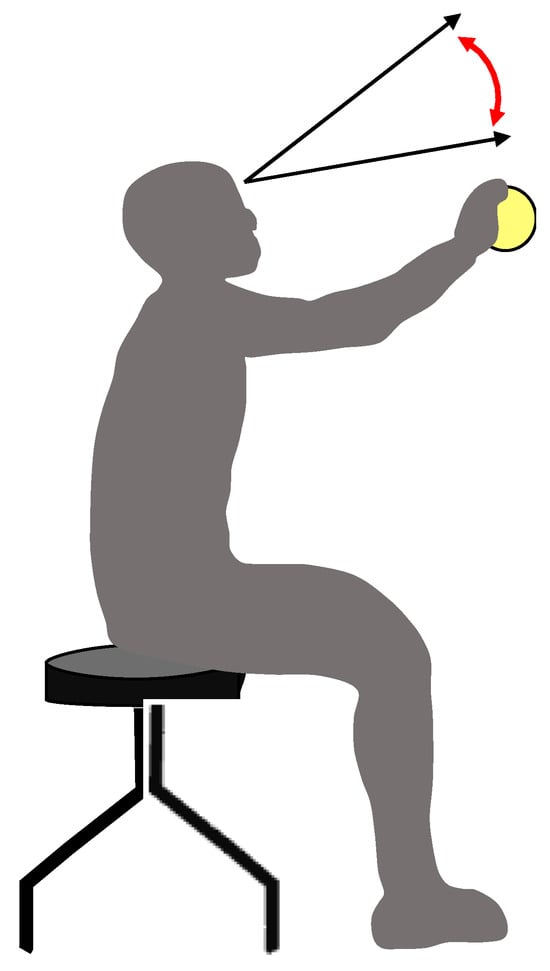
Figure 1
Open AccessArticle
Enhancement of the Inner Foveal Response of Young Adults with Extended-Depth-of-Focus Contact Lens for Myopia Management
by
Ana Amorim-de-Sousa, Rute J. Macedo-de-Araújo, Paulo Fernandes, José M. González-Méijome and António Queirós
Vision 2024, 8(2), 19; https://doi.org/10.3390/vision8020019 - 14 Apr 2024
Abstract
Background: Myopia management contact lenses have been shown to successfully decrease the rate of eye elongation in children by changing the peripheral refractive profile of the retina. Despite the efforts of the scientific community, the retinal response mechanism to defocus is still unknown.
[...] Read more.
Background: Myopia management contact lenses have been shown to successfully decrease the rate of eye elongation in children by changing the peripheral refractive profile of the retina. Despite the efforts of the scientific community, the retinal response mechanism to defocus is still unknown. The purpose of this study was to evaluate the local electrophysiological response of the retina with a myopia control contact lens (CL) compared to a single-vision CL of the same material. Methods: The retinal electrical activity and peripheral refraction of 16 eyes (16 subjects, 27.5 ± 5.7 years, 13 females and 3 males) with myopia between −0.75 D and −6.00 D (astigmatism < 1.00 D) were assessed with two CLs (Filcon 5B): a single-vision (SV) CL and an extended-depth-of-focus (EDOF) CL used for myopia management. The peripheral refraction was assessed with an open-field WAM-5500 auto-refractometer/keratometer in four meridians separated by 45° at 2.50 m distance. The global-flash multifocal electroretinogram (gf-mfERG) was recorded with the Reti-port/scan21 (Roland Consult) using a stimulus of 61 hexagons. The implicit time (in milliseconds) and response density (RD, in nV/deg2) of the direct (DC) and induced (IC) components were used for comparison between lenses in physiological pupil conditions. Results: Although the EDOF decreased both the HCVA and the LCVA (one and two lines, respectively; p < 0.003), it still allowed a good VA. The EDOF lens induced a myopic shift in most retinal areas, with a higher and statistically significant effect on the nasal retina. No differences in the implicit times of the DC and IC components were observed between SV and EDOF. Compared with the SV, the EDOF lens showed a higher RD in the IC component in the foveal region (p = 0.032). In the remaining retinal areas, the EDOF evoked lower, non-statistically significant RD in both the DC and IC components. Conclusions: The EDOF myopia control CL enhanced the response of the inner layers of the fovea. This might suggest that, besides other mechanisms potentially involved, the central foveal retinal activity might be involved in the mechanism of myopia control with these lenses.
Full article
(This article belongs to the Special Issue New Horizons in Myopia Management: Bridging Epidemiology and Clinical Innovation)
►▼
Show Figures
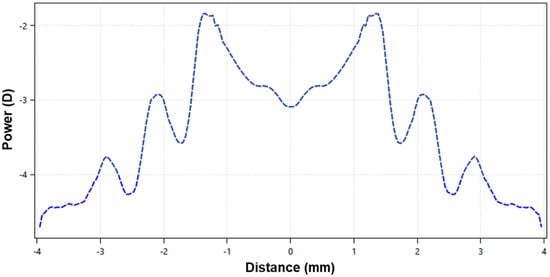
Figure 1
Open AccessArticle
The Neural Basis of a Cognitive Function That Suppresses the Generation of Mental Imagery: Evidence from a Functional Magnetic Resonance Imaging Study
by
Hiroki Motoyama and Shinsuke Hishitani
Vision 2024, 8(2), 18; https://doi.org/10.3390/vision8020018 - 10 Apr 2024
Abstract
This study elucidated the brain regions associated with the perception-driven suppression of mental imagery generation by comparing brain activation in a picture observation condition with that in a positive imagery generation condition. The assumption was that mental imagery generation would be suppressed in
[...] Read more.
This study elucidated the brain regions associated with the perception-driven suppression of mental imagery generation by comparing brain activation in a picture observation condition with that in a positive imagery generation condition. The assumption was that mental imagery generation would be suppressed in the former condition but not in the latter. The results show significant activation of the left posterior cingulate gyrus (PCgG) in the former condition compared to in the latter condition. This finding is generally consistent with a previous study showing that the left PCgG suppresses mental imagery generation. Furthermore, correlational analyses showed a significant correlation between the activation of the left PCgG and participants’ subjective richness ratings, which are a measure of the clarity of a presented picture. Increased activity in the PCgG makes it more difficult to generate mental imagery. As visual perceptual processing and visual imagery generation are in competition, the suppression of mental imagery generation leads to enhanced visual perceptual processing. In other words, the greater the suppression of mental imagery, the clearer the presented pictures are perceived. The significant correlation found is consistent with this idea. The current results and previous studies suggest that the left PCgG plays a role in suppressing the generation of mental imagery.
Full article
(This article belongs to the Special Issue Visual Mental Imagery System: How We Image the World)
►▼
Show Figures

Figure 1
Open AccessArticle
Method to Quickly Map Multifocal Pupillary Response Fields (mPRF) Using Frequency Tagging
by
Jean Lorenceau, Suzon Ajasse, Raphael Barbet, Muriel Boucart, Frédéric Chavane, Cédric Lamirel, Richard Legras, Frédéric Matonti, Maxence Rateaux, Jean-François Rouland, José-Alain Sahel, Laure Trinquet, Mark Wexler and Catherine Vignal-Clermont
Vision 2024, 8(2), 17; https://doi.org/10.3390/vision8020017 - 09 Apr 2024
Abstract
►▼
Show Figures
We present a method for mapping multifocal Pupillary Response Fields in a short amount of time using a visual stimulus covering 40° of the visual angle divided into nine contiguous sectors simultaneously modulated in luminance at specific, incommensurate, temporal frequencies. We test this
[...] Read more.
We present a method for mapping multifocal Pupillary Response Fields in a short amount of time using a visual stimulus covering 40° of the visual angle divided into nine contiguous sectors simultaneously modulated in luminance at specific, incommensurate, temporal frequencies. We test this multifocal Pupillary Frequency Tagging (mPFT) approach with young healthy participants (N = 36) and show that the spectral power of the sustained pupillary response elicited by 45 s of fixation of this multipartite stimulus reflects the relative contribution of each sector/frequency to the overall pupillary response. We further analyze the phase lag for each temporal frequency as well as several global features related to pupil state. Test/retest performed on a subset of participants indicates good repeatability. We also investigate the existence of structural (RNFL)/functional (mPFT) relationships. We then summarize the results of clinical studies conducted with mPFT on patients with neuropathies and retinopathies and show that the features derived from pupillary signal analyses, the distribution of spectral power in particular, are homologous to disease characteristics and allow for sorting patients from healthy participants with excellent sensitivity and specificity. This method thus appears as a convenient, objective, and fast tool for assessing the integrity of retino-pupillary circuits as well as idiosyncrasies and permits to objectively assess and follow-up retinopathies or neuropathies in a short amount of time.
Full article
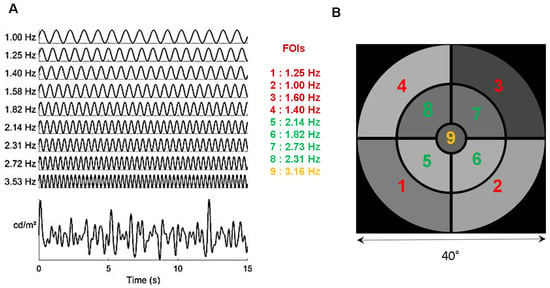
Figure 1
Open AccessReview
Transepithelial Photorefractive Keratectomy—Review
by
Christopher Way, Mohamed Gamal Elghobaier and Mayank A. Nanavaty
Vision 2024, 8(1), 16; https://doi.org/10.3390/vision8010016 - 21 Mar 2024
Abstract
The type and nature of refractive surgery procedures has greatly increased over the past few decades, allowing for almost all patient populations to be treated to extremely high satisfaction. Conventional photorefractive keratectomy involves the removal of the corneal epithelium through mechanical debridement or
[...] Read more.
The type and nature of refractive surgery procedures has greatly increased over the past few decades, allowing for almost all patient populations to be treated to extremely high satisfaction. Conventional photorefractive keratectomy involves the removal of the corneal epithelium through mechanical debridement or dilute alcohol instillation. An improvement to this method utilises laser epithelial removal in a single-step process termed transepithelial photorefractive keratectomy (transPRK). We explore the history of transPRK from its early adoption as a two-step process, identify different transPRK platforms from major manufacturers, and describe the role of transPRK in the refractive surgery armamentarium. This is a narrative review of the literature. This review finds that TransPRK is a safe and effective procedure that works across a variety of patient populations. Though often not seen as a primary treatment option when compared to other corneal-based procedures that offer a faster and more comfortable recovery, there are many scenarios in which these procedures are not possible. These include, but are not limited to, cases of corneal instability, previous refractive surgery, or transplant where higher-order aberrations can impair vision in a manner not amenable to spectacle or contact lens correction. We discuss refinements to the procedure that would help improve outcomes, including optimising patient discomfort after surgery as well as reducing corneal haze and refractive regression.
Full article
Open AccessArticle
When It’s Not Worn on the Face: Trait Anxiety and Attention to Neutral Faces Semantically Linked to Threat
by
Kim M. Curby and Jessica A. Collins
Vision 2024, 8(1), 15; https://doi.org/10.3390/vision8010015 - 19 Mar 2024
Abstract
While our direct observations of the features or behaviours of the stimuli around us tell us much about them (e.g., should they be feared?), the origin of much of our knowledge is often untethered from directly observable properties (e.g., through what we have
[...] Read more.
While our direct observations of the features or behaviours of the stimuli around us tell us much about them (e.g., should they be feared?), the origin of much of our knowledge is often untethered from directly observable properties (e.g., through what we have learned or have been told about them, or “semantic knowledge”). Here, we ask whether otherwise neutral visual stimuli that participants learn to associate with emotional qualities in the lab cause the stimuli to be attended in a similar way as stimuli whose emotional qualities can be discerned through their visual properties. In Experiment 1, participants learned to associate negative or neutral characteristics with neutral faces, which then served as valid or invalid spatial cues to targets in an attentional disengagement paradigm. The performance of participants higher in trait anxiety was consistent with attentional avoidance of faces with learned negative associations, while participants lower in trait anxiety showed a general response slowing in trials with these stimuli, compared to those with neutral associations. In contrast, in Experiment 2, using (visually) expressive (angry) faces, the performance of participants higher in trait anxiety was consistent with difficulty disengaging from visually threatening faces, while the performance of those with lower trait anxiety appeared unaffected by the valence of the stimuli. These findings suggest that (1) emotionality acquired indirectly via learned semantic knowledge impacts how attention is allocated to face stimuli, and this impact is influenced by trait anxiety, and (2) there are differences in the effects of stimulus emotionality depending on whether it is acquired indirectly or directly via the perceptual features of the stimulus. These differences are discussed in the context of the variability of attention bias effects reported in the literature and the time course of impacts of emotionality on stimulus processing.
Full article
(This article belongs to the Special Issue What We Bring to the Perceptual Table: Perceiver-Based Factors in Visual Perception)
►▼
Show Figures

Figure 1
Open AccessProtocol
Automated Analysis Pipeline for Extracting Saccade, Pupil, and Blink Parameters Using Video-Based Eye Tracking
by
Brian C. Coe, Jeff Huang, Donald C. Brien, Brian J. White, Rachel Yep and Douglas P. Munoz
Vision 2024, 8(1), 14; https://doi.org/10.3390/vision8010014 - 18 Mar 2024
Abstract
►▼
Show Figures
The tremendous increase in the use of video-based eye tracking has made it possible to collect eye tracking data from thousands of participants. The traditional procedures for the manual detection and classification of saccades and for trial categorization (e.g., correct vs. incorrect) are
[...] Read more.
The tremendous increase in the use of video-based eye tracking has made it possible to collect eye tracking data from thousands of participants. The traditional procedures for the manual detection and classification of saccades and for trial categorization (e.g., correct vs. incorrect) are not viable for the large datasets being collected. Additionally, video-based eye trackers allow for the analysis of pupil responses and blink behaviors. Here, we present a detailed description of our pipeline for collecting, storing, and cleaning data, as well as for organizing participant codes, which are fairly lab-specific but nonetheless, are important precursory steps in establishing standardized pipelines. More importantly, we also include descriptions of the automated detection and classification of saccades, blinks, “blincades” (blinks occurring during saccades), and boomerang saccades (two nearly simultaneous saccades in opposite directions where speed-based algorithms fail to split them), This is almost entirely task-agnostic and can be used on a wide variety of data. We additionally describe novel findings regarding post-saccadic oscillations and provide a method to achieve more accurate estimates for saccade end points. Lastly, we describe the automated behavior classification for the interleaved pro/anti-saccade task (IPAST), a task that probes voluntary and inhibitory control. This pipeline was evaluated using data collected from 592 human participants between 5 and 93 years of age, making it robust enough to handle large clinical patient datasets. In summary, this pipeline has been optimized to consistently handle large datasets obtained from diverse study cohorts (i.e., developmental, aging, clinical) and collected across multiple laboratory sites.
Full article
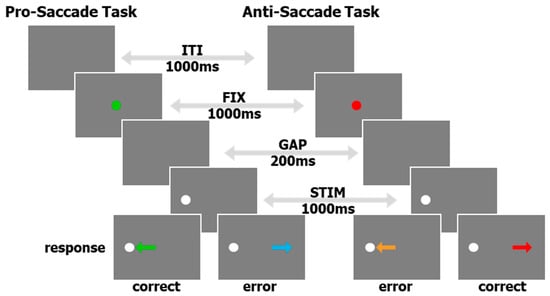
Figure 1
Open AccessArticle
Associations between Autistic-like Traits and Imagery Ability
by
Takao Hatakeyama
Vision 2024, 8(1), 13; https://doi.org/10.3390/vision8010013 - 12 Mar 2024
Abstract
This article examines empirical associations between qualities of the imagination, mental imagery, and cognitive abilities with special reference to autism. This study is the first to explore the empirical relationships between autistic-like traits and tests of imagery differences. Imaginative impairments and distinctive sensory
[...] Read more.
This article examines empirical associations between qualities of the imagination, mental imagery, and cognitive abilities with special reference to autism. This study is the first to explore the empirical relationships between autistic-like traits and tests of imagery differences. Imaginative impairments and distinctive sensory characteristics in individuals with autism spectrum disorder (ASD) should be reflected in their interactions with mental imagery. However, the relationship between ASD and imaging traits remains unclear. Based on the hypothesis that the degree of autistic-like traits is reflected in imagery traits, this study examined how the individual Autism Spectrum Quotient (AQ) relates to imagery ability in 250 college students. Two vividness tests and one imagery-type test were used to assess imagery ability. Scores in each imagery test were compared between the high-scoring group classified by the AQ and the rest of the participants and between the low-scoring group classified by the AQ and the other participants. This study also directly compared imagery test scores between the high- and low-scoring groups. In terms of the total AQ score, the high-scoring group exhibited lower visualization scores. Regarding AQ subscales, “imagination” had the most extensive relationship with imagery traits, with the high-scoring group (unimaginative) showing lower imagery vividness across various modalities as well as lower visualization and verbalization scores. This was followed by the “attention to detail” subscale, on which the high-scoring group (attentive to detail) showed higher vividness of visual imagery. The results of the low-scoring group exhibited, on the whole, opposite imagery tendencies to the high-scoring group. The results indicate that autistic-like traits are associated with qualities of the imagination and especially mental imagery ability.
Full article
(This article belongs to the Special Issue Visual Mental Imagery System: How We Image the World)
Open AccessConference Report
Abstracts of Scottish Vision Group 2023 Meeting
by
Paul George Lovell and Rebecca J. Sharman
Vision 2024, 8(1), 12; https://doi.org/10.3390/vision8010012 - 11 Mar 2024
Abstract
Scottish Vision Group has become a yearly event for vision scientists based in Scotland since its inception in 2001. Each year, the conference is hosted at a different location and organised by a different team. The 2023 SVG meeting was hosted in the
[...] Read more.
Scottish Vision Group has become a yearly event for vision scientists based in Scotland since its inception in 2001. Each year, the conference is hosted at a different location and organised by a different team. The 2023 SVG meeting was hosted in the city of Dundee by Abertay University. Delegates travelled from the United Kingdom, Europe and beyond. The meeting started with a roundtable panel discussion sponsored by Meta Reality Labs. The roundtable, titled The Past, Present and Future of Visual Search, was organised and presented by Árni Kristjánsson (Iceland), Ioan Smart (Abertay) and Ian Thornton (Malta). The MDPI Keynote lecture was introduced by Professor Andrew Parker (Oxford University and Otto-von-Guericke University in Magdeburg, Germany) and presented by Prof. Timothy Ledgeway (Nottingham) on sensory eye dominance and plasticity in adult binocular vision. The remaining two days of the conference hosted a wide range of talks on topics ranging from insect navigation to visual illusions, facial recognition and binocular coding. The Saturday evening saw a special event where delegates explored the sensory properties of a range of single-malt whiskies. Here, we present a selection of abstracts for the various talks and posters.
Full article
(This article belongs to the Special Issue Selected Papers from the Scottish Vision Group Meeting 2023)
Open AccessArticle
Daytime Changes in Tear Film Parameters and Visual Acuity with New-Generation Daily Disposable Silicone Hydrogel Contact Lenses—A Double-Masked Study in Symptomatic Subjects
by
Rute J. Macedo-de-Araújo, Laura Rico-del-Viejo, Vicente Martin-Montañez, António Queirós and José M. González-Méijome
Vision 2024, 8(1), 11; https://doi.org/10.3390/vision8010011 - 05 Mar 2024
Abstract
►▼
Show Figures
This prospective, double-masked, contralateral study aimed to analyze and compare daytime changes in pre-lens tear film (PLTF) stability and optical quality in symptomatic subjects wearing two contact lenses (CL). A secondary goal was to assess the performance of the PLTF by using dynamic
[...] Read more.
This prospective, double-masked, contralateral study aimed to analyze and compare daytime changes in pre-lens tear film (PLTF) stability and optical quality in symptomatic subjects wearing two contact lenses (CL). A secondary goal was to assess the performance of the PLTF by using dynamic topography techniques and analyzing surface asymmetry and irregularity indexes (SAI and SRI, respectively). Measurements were conducted on 20 symptomatic subjects (OSDI score > 13). Participants were fitted contralaterally and randomly with spherical Delefilcon A and Stenfilcon A CLs and underwent a series of measurements over 3 consecutive days: three in the morning (after 1–2 h of CL wear) and three in the afternoon (after 7–9 h of CL wear). High- and low-contrast visual acuity (HCVA and LCVA, respectively), pre-lens NIBUT, and dynamic topography were assessed. The contralateral fit of the two lenses allowed a direct and better comparison between them since they were exposed to the same conditions during the day. Consequently, both lenses demonstrated similar performance in HCVA, LCVA, and PLTF stability, with no statistically significant differences between them, although some fluctuations were observed throughout the day. Dynamic topography proved sensitive in evaluating temporal changes in the PLTF. The SRI index showed greater sensitivity to topographic changes due to lacrimal destabilization, making it potentially valuable for evaluating dry eye patients.
Full article
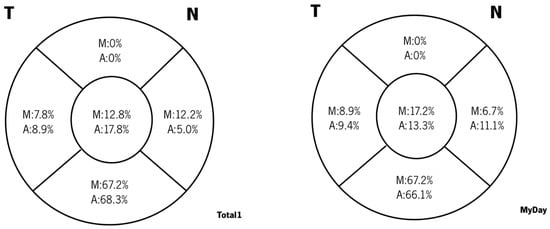
Figure 1
Open AccessReview
Angioid Streaks Remain a Challenge in Diagnosis, Management, and Treatment
by
Georgios Tsokolas, Charalambos Tossounis, Straton Tyradellis, Lorenzo Motta, Georgios D. Panos and Theo Empeslidis
Vision 2024, 8(1), 10; https://doi.org/10.3390/vision8010010 - 05 Mar 2024
Abstract
Aim: Angioid streaks (ASs) are a rare retinal condition and compromise visual acuity when complicated with choroidal neovascularization (CNV). They represent crack-like dehiscences at the level of the Bruch’s membrane. This objective narrative review aims to provide an overview of pathophysiology, current
[...] Read more.
Aim: Angioid streaks (ASs) are a rare retinal condition and compromise visual acuity when complicated with choroidal neovascularization (CNV). They represent crack-like dehiscences at the level of the Bruch’s membrane. This objective narrative review aims to provide an overview of pathophysiology, current treatment modalities, and future perspectives on this condition. Materials and Methods: A literature search was performed using “PubMed”, “Web of Science”, “Scopus”, “ScienceDirect”, “Google Scholar”, “medRxiv”, and “bioRxiv.” Results: ASs may be idiopathic, but they are also associated with systemic conditions, such as pseudoxanthoma elasticum, hereditary hemoglobinopathies, or Paget’s disease. Currently, the main treatment is the use of anti-vascular endothelial growth factors (anti-VEGF) to treat secondary CNV, which is the major complication observed in this condition. If CNV is detected and treated promptly, patients with ASs have a good chance of maintaining functional vision. Other treatment modalities have been tried but have shown limited benefit and, therefore, have not managed to be more widely accepted. Conclusion: In summary, although there is no definitive cure yet, the use of anti-VEGF treatment for secondary CNV has provided the opportunity to maintain functional vision in individuals with AS, provided that CNV is detected and treated early.
Full article
(This article belongs to the Section Retinal Function and Disease)
►▼
Show Figures
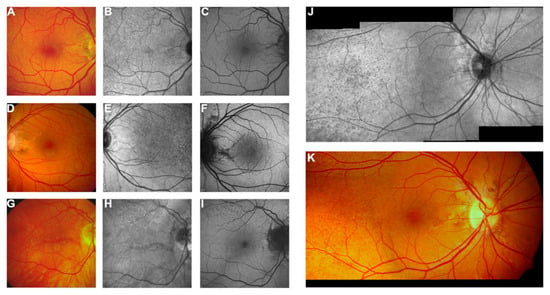
Figure 1
Open AccessReview
Astigmatism Management in Modern Cataract Surgery
by
Royce B. Park and Ahmad A. Aref
Vision 2024, 8(1), 9; https://doi.org/10.3390/vision8010009 - 27 Feb 2024
Abstract
►▼
Show Figures
Astigmatism management is a frequently encountered challenge in the world of modern cataract surgery. This review article investigates the importance of astigmatic correction and seeks to uncover the critical components of preoperative evaluation. With the rapid growth of new technologies and techniques, this
[...] Read more.
Astigmatism management is a frequently encountered challenge in the world of modern cataract surgery. This review article investigates the importance of astigmatic correction and seeks to uncover the critical components of preoperative evaluation. With the rapid growth of new technologies and techniques, this article aims to also catalogue and clarify the multitude of astigmatism treatment options available for the cataract surgeon.
Full article
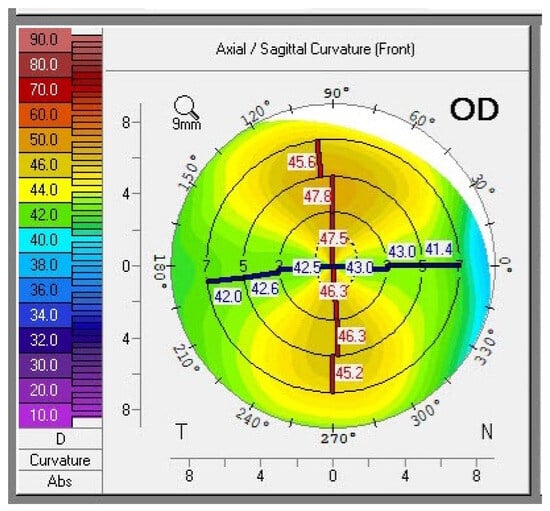
Figure 1
Open AccessArticle
The Influence of Tear Film Quality on Visual Function
by
Snježana Kaštelan, Ksenija Gabrić, Maša Mikuličić, Danijela Mrazovac Zimak, Mirela Karabatić and Antonela Gverović Antunica
Vision 2024, 8(1), 8; https://doi.org/10.3390/vision8010008 - 26 Feb 2024
Abstract
►▼
Show Figures
Background: The prevalence of dry eye disease (DED) is increasing globally, resulting in a variety of eye symptoms characterized by discomfort and visual disturbances. The accurate diagnosis of the disease is often challenging and complex, requiring specialized diagnostic tools. This study aimed to
[...] Read more.
Background: The prevalence of dry eye disease (DED) is increasing globally, resulting in a variety of eye symptoms characterized by discomfort and visual disturbances. The accurate diagnosis of the disease is often challenging and complex, requiring specialized diagnostic tools. This study aimed to investigate the impact of tear film instability on visual function and to evaluate the value of post-blink blur time (PBBT) as an alternative method for assessing tear film stability. Methods: The study included 62 subjects: 31 with subjective symptoms of DED (Group A) and a control group consisting of 31 healthy participants (Group B). Symptoms were assessed using the standard Schein questionnaire, supplemented with additional questions. PBBT was measured using standard Snellen charts to investigate a potential association between PBBT and tear film dysfunction. Additional clinical assessments included tear film break-up time (TBUT). Results: Statistically significant differences were observed in the average values of PBBT and TBUT between the examined groups. The average PBBT was 8.95 ± 5.38 s in the group with DED and 14.66 ± 10.50 s in the control group, p < 0.001. Group A exhibited an average TBUT of 4.77 ± 2.37 s, while Group B had a TBUT of 7.63 ± 3.25 s, p < 0.001. Additionally, a strong positive correlation was identified between PBBT and TBUT values (r = 0.455; p < 0.001). Conclusions: The research confirms that tear film stability has an important role in the refraction of light and the maintenance of optical quality of vision. PBBT could potentially function as an objective and clinically significant screening test for DED.
Full article
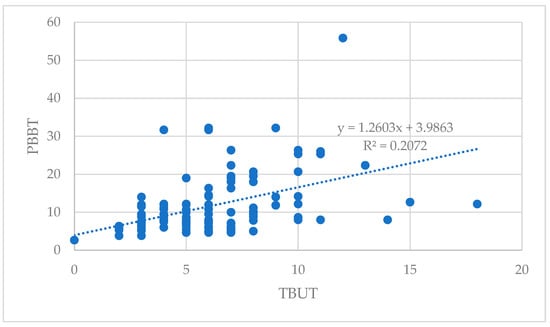
Figure 1
Open AccessArticle
Default Reference Frames for Angular Expansion in the Perception of Visual Direction
by
Prince U. D. Tardeh, Crystal Xu and Frank H. Durgin
Vision 2024, 8(1), 7; https://doi.org/10.3390/vision8010007 - 21 Feb 2024
Abstract
►▼
Show Figures
Prior work has shown that perceived angular elevation relative to a visible horizon/ground plane is exaggerated with a gain of about 1.5. Here, we investigated whether estimates of angular elevation remain exaggerated when no such visual gravitational reference is provided. This was investigated
[...] Read more.
Prior work has shown that perceived angular elevation relative to a visible horizon/ground plane is exaggerated with a gain of about 1.5. Here, we investigated whether estimates of angular elevation remain exaggerated when no such visual gravitational reference is provided. This was investigated using a series of five experiments, with most using a novel apparatus to view a large field-of-view stereoscopic virtual environment while lying supine, looking straight up. Magnitude estimation methods were used as well as psychometric matches to internal standards with a total of 133 human participants. Generally, it was found that the exaggerated scaling of elevation seemed to be a default for 3D space, even if testing was performed in virtual environments that were nearly empty. Indeed, for supine observers, a strong exaggeration was found even for azimuthal judgments, which is consistent with the idea that, when looking upward, all deviations are in elevation. This suggests that the overarching gravitational frame often serves as a default reference frame.
Full article
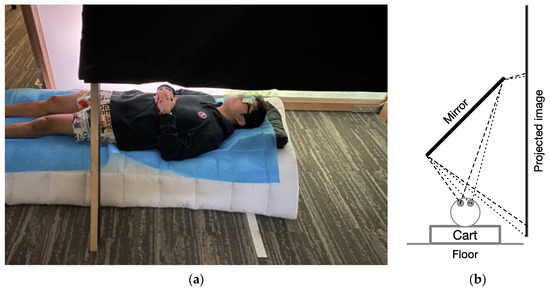
Figure 1
Open AccessArticle
Kinematic Assessment of Fine Motor Skills in Children: Comparison of a Kinematic Approach and a Standardized Test
by
Ewa Niechwiej-Szwedo, Taylor A. Brin, Benjamin Thompson and Lisa W. T. Christian
Vision 2024, 8(1), 6; https://doi.org/10.3390/vision8010006 - 17 Feb 2024
Cited by 1
Abstract
►▼
Show Figures
Deficits in fine motor skills have been reported in some children with neurodevelopmental disorders such as amblyopia or strabismus. Therefore, monitoring the development of motor skills and any potential improvement due to therapy is an important clinical goal. The aim of this study
[...] Read more.
Deficits in fine motor skills have been reported in some children with neurodevelopmental disorders such as amblyopia or strabismus. Therefore, monitoring the development of motor skills and any potential improvement due to therapy is an important clinical goal. The aim of this study was to test the feasibility of performing a kinematic assessment within an optometric setting using inexpensive, portable, off-the-shelf equipment. The study also assessed whether kinematic data could enhance the information provided by a routine motor function screening test (the Movement Assessment Battery for Children, MABC). Using the MABC-2, upper limb dexterity was measured in a cohort of 47 typically developing children (7–15 years old), and the Leap motion capture system was used to record hand kinematics while children performed a bead-threading task. Two children with a history of amblyopia were also tested to explore the utility of a kinematic assessment in a clinical population. For the typically developing children, visual acuity and stereoacuity were within the normal range; however, the average standardized MABC-2 scores were lower than published norms. Comparing MABC-2 and kinematic measures in the two children with amblyopia revealed that both assessments provide convergent results and revealed deficits in fine motor control. In conclusion, kinematic assessment can augment standardized tests of fine motor skills in an optometric setting and may be useful for measuring visuomotor function and monitoring treatment outcomes in children with binocular vision anomalies.
Full article
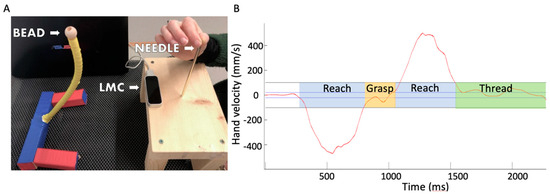
Figure 1
Open AccessArticle
New Evidence for Retrospectively Cued Perception
by
Bence Szaszkó, Moritz Stolte, Lea Bachmann and Ulrich Ansorge
Vision 2024, 8(1), 5; https://doi.org/10.3390/vision8010005 - 06 Feb 2024
Abstract
►▼
Show Figures
Past research suggests a continuity between perception and memory, as reflected in influences of orienting of spatial attention by cues presented after a visual target offset (post-target cues) on target perception. Conducting two experiments, we tested and confirmed this claim. Our study revealed
[...] Read more.
Past research suggests a continuity between perception and memory, as reflected in influences of orienting of spatial attention by cues presented after a visual target offset (post-target cues) on target perception. Conducting two experiments, we tested and confirmed this claim. Our study revealed an elevated reliance on post-target cues for target detection with diminishing target visibility, leading to better performance in validly versus invalidly cued trials, indicative of contrast gain. We demonstrated this post-target cueing impact on target perception without a postcue response prompt, meaning that our results truly reflected a continuity between perception and memory rather than a task-specific impact of having to memorize the target due to a response prompt. While previous studies found an improvement in accuracy through valid compared to invalid cues using liminal targets, in Experiment 1, we further showed an influence of attention on participants’ response time by the post-target cues with cues presented away from a clearly visible target. This suggests that visual interactions at the target location provided no better explanation of post-target cueing effects. Our results generalize prior research with liminal targets and confirm the view of a perception–memory continuum so that visual target processing is not shielded against visuospatial orienting of attention elicited by events following the offset of the visual target.
Full article
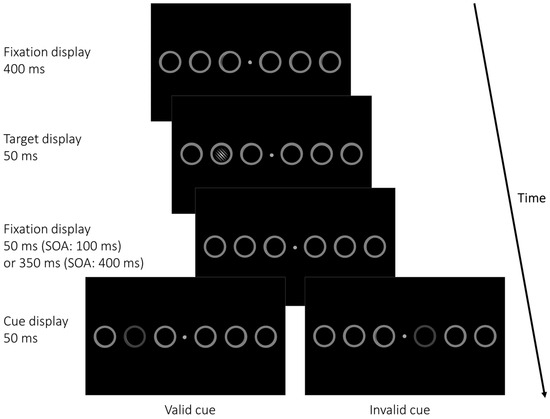
Figure 1
Highly Accessed Articles
Latest Books
E-Mail Alert
News
Topics

Conferences
Special Issues
Special Issue in
Vision
Selected Papers from the 4th International Symposium on Visual Physiology, Environment, and Perception (VisPEP 2024)
Guest Editors: Jacek Pniewski, Aiga Svede, Tatjana PladereDeadline: 30 June 2024
Special Issue in
Vision
New Horizons in Myopia Management: Bridging Epidemiology and Clinical Innovation
Guest Editors: Yair Morad, Nir ErdinestDeadline: 20 September 2024
Special Issue in
Vision
Perceptual Experience and the Impact of Artificial Intelligence on Vision Research
Guest Editors: Paul Hibbard, Jordi M. Asher, Ross Goutcher, Aysha MotalaDeadline: 30 September 2024
Special Issue in
Vision
Visual Mental Imagery System: How We Image the World
Guest Editor: David F. MarksDeadline: 31 October 2024




